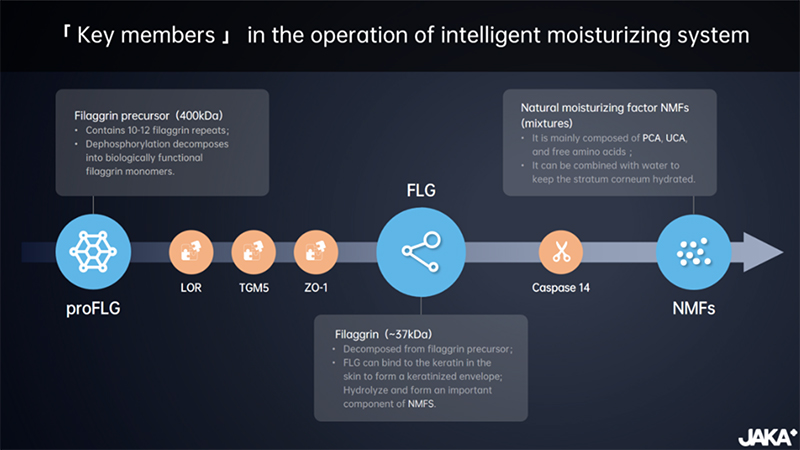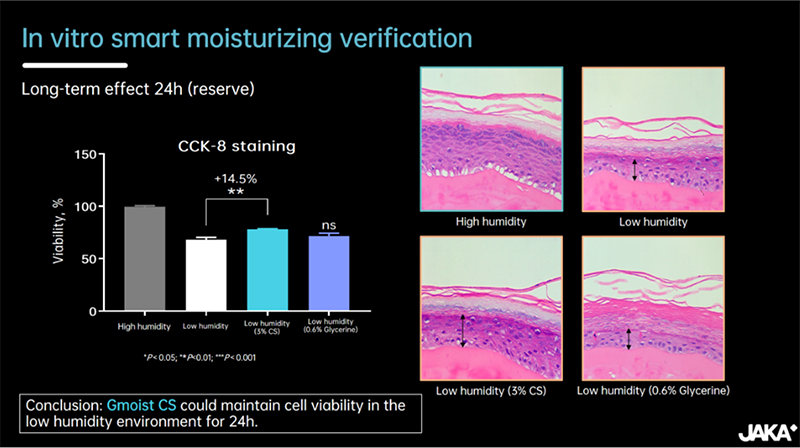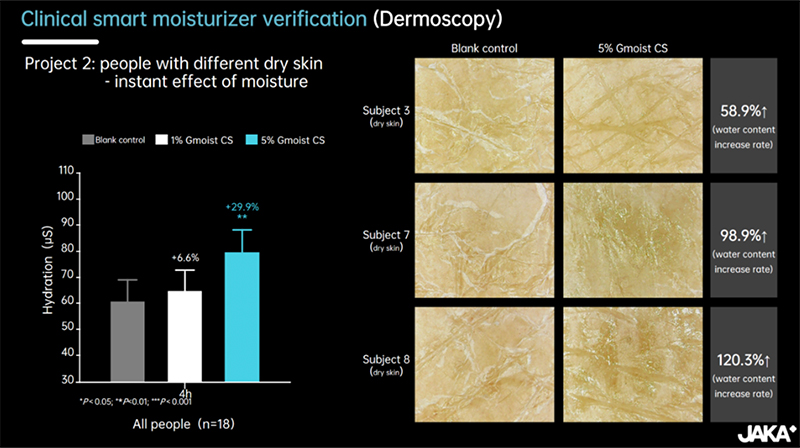This technical article was independently finished by JAKA team with 2.189 Impact Factor. At present, polysaccharides and alkaloids from various plant sources are widely used as skin moisturisers. 5-9 Macromolecular polysaccharides and alkaloids contain multiple hydroxyl, carboxyl, and polar groups, which are capable of fixing skin moisture by forming hydrogen bonds with water. In addition, polysaccharides have good film-forming properties, and thereby reduce moisture evaporation from the skin surface. Small molecules derived from plants such as betaine and rhamnose are widely used because of their strong skin penetration and accessorial moisturising properties.
In response to this recognition, JAKA prepared a novel C. spinosa extract extract (Gmoist CS) containing quaternary ammonium alkaloids but no polysaccharides to investigate its in vivo and in vitro skin moisturise efficacy.
Multiple mechanisms such as the aquaporin pathway, keratinocyte desmosomal and tight junction pathway, and hyaluronic acid pathway can produce the moisturising effect. Filaggrin (FLG), an important component of the keratinised envelope, participates in an intelligent regulatory pathway to regulate skin homeostasis. Profilaggrin (pro-FLG) is synthesised in the granular layer and after a series of hydrolysis, FLG monomers are formed. FLG monomers together with loricrin and keratin form a keratinised envelope to maintain the integrity of the stratum corneum. FLG in the stratum corneum can be decomposed into free amino acids by caspase 14, bleomycin hydrolase, calpain 1, etc. to form natural moisturising factors (NMFs) such as pyrrolidone carboxylate acid (PCA), urocanic acid (UCA), etc. regulating skin hydration. JAKA focuses on the innovative mechanism from pro-FLG to FLG to NMFs.

Filaggrin participates in an intelligent regulatory pathway to regulate skin homeostasis. Cau et al. reported that low environmental humidity induced stratum corneum thickening and stimulated FLG breakdown in reconstructed human epidermis (RHEs) when cultured for 10 days after air–liquid interface exposure. Accordingly, a reconstructed skin model was used to elucidate the effect of Gmoist CS instantly increasing skin moisture content. Here, we found that Gmoist CS could maintain cell viability in the low humidity environment for 24h.

JAKA conducts clinical intelligent moisturising tests. Firstly, the tests were conducted on different dry skin parts, high humidity: face (190.1 μS), medium humidity: arms (105.2 μS), and low humidity: shanks (60.3 μS). The result showed that Gmoist CS had an intelligent regulation effect on parts with different water content. The drier the part, the stronger the effect. Secondly, the tests were conducted on different dry skin people: dry skin people 43.0±7.8 μS, partially dry skin people 104.7±10.0 μS). It showed that for people with dry and partially dry skin, the skin scaling index can be reduced by Gmoist CS, and the reduction effect is more obvious for dry skin people.

Through in vivo and in vitro experiments, we showed that Gmoist CS (C. spinosa fruit extract) can improve skin moisture content by regulating FLG synthesis and degradation. It is a novel finding about FLG metabolism/catabolism in vitro that 4 h is sufficient to induce FLG degradation. This study also finds the intelligent moisturising effect on people skin, the drier skin, the bigger effect.
Read original article HERE.
Learn more about Smopore LC HERE.




